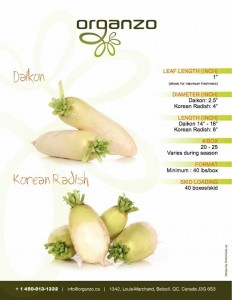Korean Radish
Introduction
Like all radishes in the daikon family, the Korean radish originates from East Asia. It gets its common name from the Korean peninsula where it is cultivated en masse. Its shape resembles that of a potato (stocky), while the shape of other varieties of daikon is more like that of a large carrot (longitudinal).
One must not confuse the Korean radish with the daikon, all Koreans can tell the difference between the two varieties. In fact, the Korean radish is shorter and rounder than the daikon, it has a green neck, its texture is denser and its taste is slightly more pronounced than that of the daikon which has a relatively mild flavour. Its flesh is a pretty green colour (due to the chlorophyll), it has a good acid-base balance and the root colour transitions towards a creamy white.
This radish is an important part of a meal for Korean families. It is firm, very crunchy and very resistant when cooked. The leaves are edible and it can be used in salads and side dishes, in particular in kimchi.
Organzo: a strategic and authentic partnership between truck farmers and our agronomic services department, from seed to harvest.
We constantly suggest new varieties to improve product qualityand options for seeds that are less prone to ravagers, diseases and physiological disorders.
We walk through the producers’ fields every week looking at and inspecting the slightest defaults in plants, in order to delay any outbreak of ravagers and/or diseases by applying good agricultural practices, and when needed, by rationally using registered pesticides.
Selection and preservation
A good Korean radish is firm and heavy, has luminous skin with no lines. The top of the radish should be a pale green colour.
To store it, you must wrap it in plastic. If you eat it raw, use it within two or three days.
Its flavour is stronger in autumn and winter.
Wash and peel the Korean radish properly.
Cooking instructions
Wash and peel the radish before preparing it.
When raw, the flavour of this radish is a bit more pronounced than the Chinese radish, it is slightly bitter, spicy and sweet at the same time.
Grated, it is a great aid for people who have a fragile stomach. You must however, eat the grated radish immediately as in only 30 minutes nearly 50% of its enzymes are destroyed.
Thinly sliced or in cubes, we can braise it in soups or stews, or use its flavour in seafood or crustacean dishes, or mix finely grated radish in some natural yoghurt.


